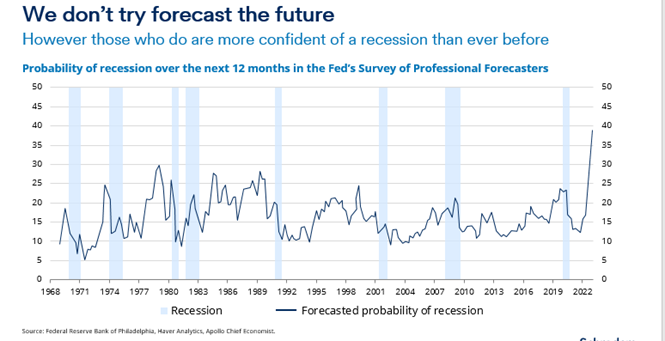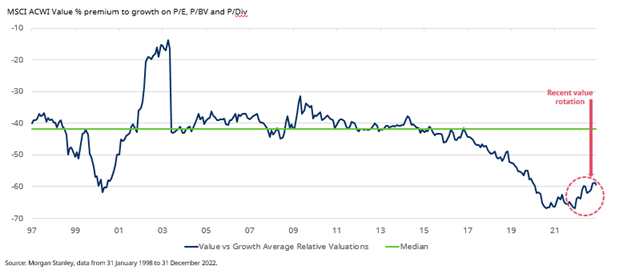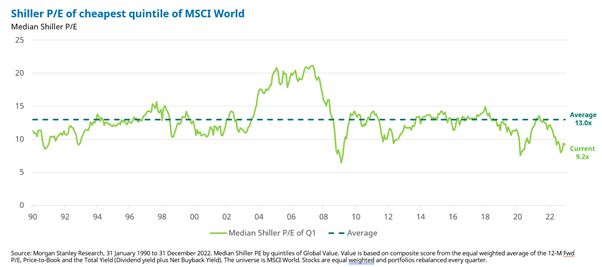Value Perspective Quarterly Letter – Q4 2022 – Global
Our quarterly note covering global markets

Authors
Looking into our crystal ball
Multiple studies have shown that economists and pundits predictions are no better than tossing a coin. Moreover, availability bias means that forecasters usually stick too closely to the prevailing norms, and on those rare occasions when they call for change they often underestimate the potential magnitude.
With that in mind, we believe using our time to try and forecast the exact future path of economic variables would be time wasted. Instead, it is better to look for valuation extremes, which are a reflection of investor’s confidence one way or another, and simply ask: “might that confidence be misplaced?”. Might things that currently look bleak improve? Might things that currently look fantastic deteriorate slightly? History suggests that few things stay the same over time, and as investors, being positioned ahead of any change can be extremely profitable.
At this point last year, we wrote that the areas of the stock market where investors were most pessimistic were oil and gas and banks shares. During 2022, those sectors had a good year, although for reasons none of us would have been able to predict. We simply based our view on which sectors were most out of favour, which were cheapest, and therefore set to benefit the most if there was any alleviation of the negative headwinds those stocks had been facing. Last year, that worked out pretty well.
Today, the most vexing issue for investors is the forthcoming consumer recession. It is rare for economists to forecast recessions; famously the Bank of England has never forecast a recession – until now. Today, however, forecasters in the US are as sure as they’ve ever been. A recession is coming
The most anticipated recession ever

Source: Federal Reserve Bank of Philadelphia, Haver Analytics, Apollo Chief Economist
A ‘cost of living’ crisis is affecting people around the globe already; higher food and energy prices coupled with increased debt servicing costs providing an inevitable squeeze on consumers. That much we know. What we don’t know, is what we don’t know. Surprising things may happen to make things better. Surprising things may happen to make things worse. Those ‘unknown unknowns’ are what makes forecasting difficult.
Stock markets, of course, are forward looking. Share prices don’t wait for recessions to be announced before going down, nor wait for positive GDP figures to be announced before going up. The stock market has been particularly ruthless this year in marking down the share prices of consumer-related stocks in anticipation of tough times ahead.
So far, this outlook statement has mainly focussed on what has happened during the past year. We do so deliberately as to know where we are going, it is helpful to first know where we are starting from. To recap: our forecasts last year were reasonably accurate by simply focussing on the cheapest areas of the market. The consumer is extremely likely to have a tough time in 2023, but consumer exposed share prices have declined significantly in advance.
Leaning into the areas of opportunity
To ensure our portfolios do not have style drift, and to ensure they represent the best opportunities today, we have been taking money out of the oil and gas and mining companies. These are areas which have done relatively well over the past couple of years. We are rotating the proceeds into the areas most out of favour, where people are most pessimistic, and where valuations are lowest.
We are not doing so oblivious to the likely difficulties head, and are aiming to only buy the ones where balance sheets are strong enough to see them through some tough times. With the valuations these companies trade on, and the upside we see in a more normal economic environment, we would hope they are likely to be the foundations of our portfolio’s performance over the next three to five years.
A few comments on risk are worth making at this point. Economists are not the only ones who struggle to forecast economies. When times are good, companies themselves cannot foresee changes, and often take on debt to expand, to pay large dividends, or to acquire competitors. When economic turbulence inevitably arrives, companies often find themselves overleveraged, with balance sheets ill-suited to the new economic reality.
This time is somewhat different. While headlines are worrisome, companies have had time to prepare. All remember the lessons from the Covid downturn. Indeed, some are still flush with liquidity raised during the Covid months and rebound.
That is not a unanimous position of strength, and as investors we need to be careful. Within the aggregate, there are a number of businesses where balance sheets are stretched, or where liquidity is low. Debt markets are less forgiving than they have been in recent years, and indeed have been closed to high yield issuance for much of the past year. This speaks to the importance of being extremely cautious when it comes to financial risk as some businesses will struggle to refinance maturing debt facilities.
Inevitably, that will result in some businesses turning to equity markets to plug their funding gap. Few portfolios have the remit to proactively seek these businesses out. Our Recovery funds are almost unique within the industry as having a sophisticated client base who understand the returns that can be generated from these situations. Whilst we are extremely unlikely to participate in all equity issuances, as one of the few industry participants with the specialist skills to evaluate rescue rights issues, we strive for a seat at the negotiation table with each of them. This can be time consuming, but for those companies where a fresh equity injection is part of a holistic refinancing package which removes the financial risk from the company, these opportunities can be extremely profitable for our clients.
Many outlook statements will reference the almost inevitably difficult times ahead – as we have above. However, we’d like to finish on two bits of good news. The first is that that valuation spreads remain elevated. Although not as wide as they were coming into 2022, the gap remains sufficient to provide a strong tail wind for value investors over the coming years. We need to recognise that the tailwind may not blow in 2023 itself, but over the next three to five years, the outlook for valuation based investors from a relative perspective is a strong one.
Value looks attractive on a relative basis …
Value’s median discount to growth has been 42% since 1975. You can see that whenever the discount moves significantly above or below this level (dotted blue line), mean reversion kicks in to bring it back to this long run median.

Despite value’s recent strong run of performance, it still trades at a c.60% discount to growth, and far below the long-term median. Whichever region you pick the story is the same; in the UK, Europe, emerging markets or globally, value is still on sale.
There is only one precedent for today’s level of valuation dispersion; the post dotcom era. Proponents of the value style will hope mean reversion will continue to offer a powerful tailwind for its continued outperformance.
Of course, this argument is built on relative valuations. While the low relative valuations and the potential relative outperformance is welcomed, it is absolute performance that grows capital.
… and value is attractive on an absolute basis too
Despite value’s strong performance of late, absolute valuations remain extremely compelling. The cheapest quintile of the global equity market is trading on a cyclically-adjusted PE of 9.8x, which is 25% below its long term average. Low absolute valuations give us confidence in for long-term prospective returns for the cheapest part of the market.

The second thing to focus on is the remarkable opportunities there are for long term patient investors. For those of us willing (or able) to take a three to five year investment horizon there are significant numbers of stocks which screen as attractive, in diverse sectors, across the global equity market. This offers the opportunity (but not guarantee) for strong absolute returns in the coming years.
Subscribe to our Insights
Visit our preference centre, where you can choose which Schroders Insights you would like to receive.
Authors
Topics